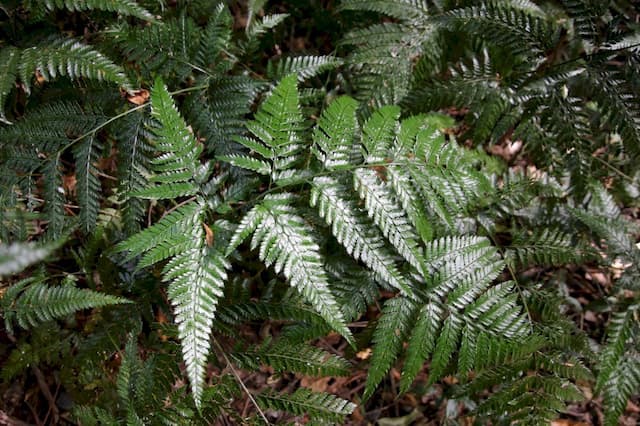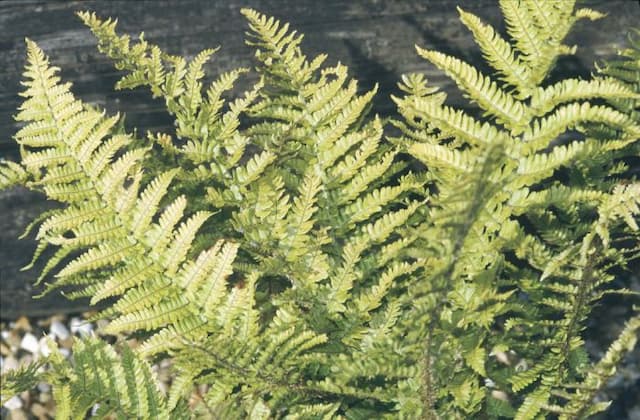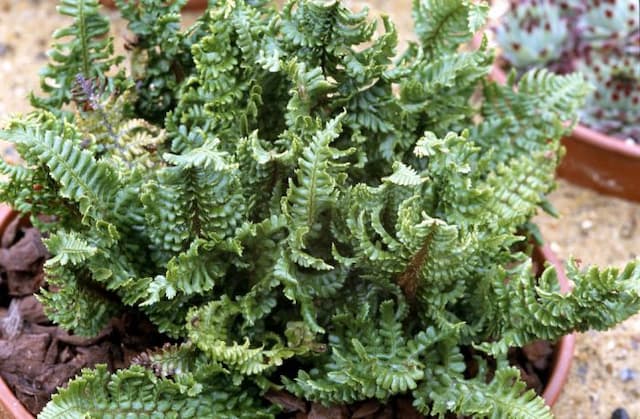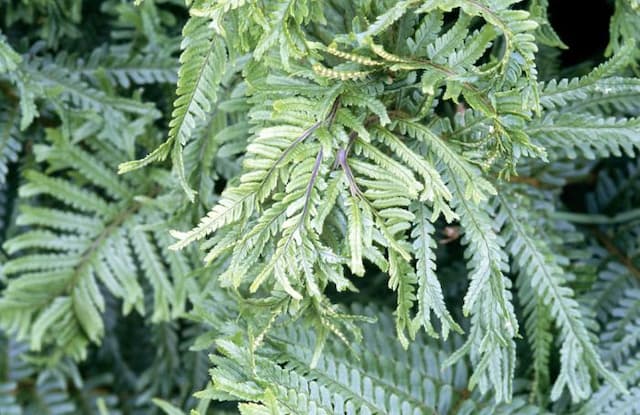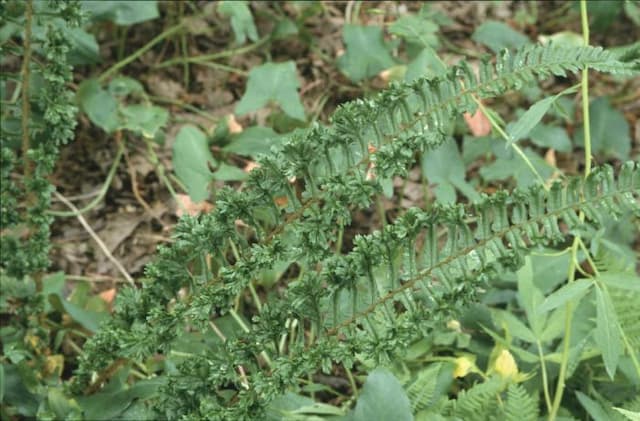Male fern Dryopteris filix-mas 'Linearis Polydactyla'
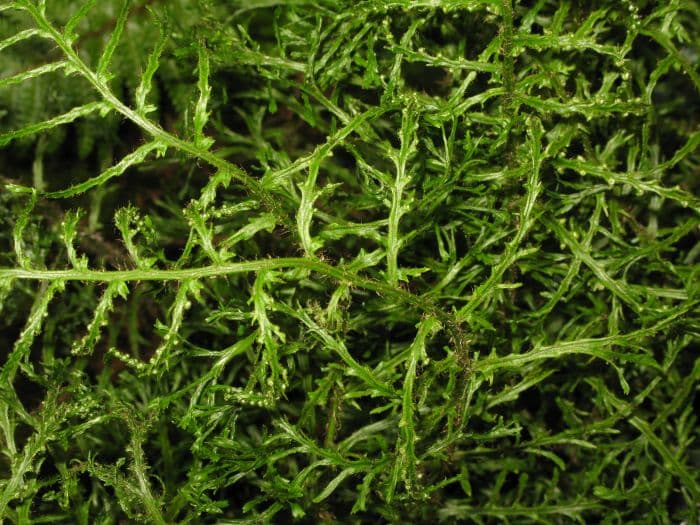

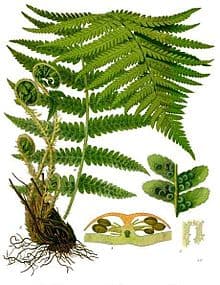
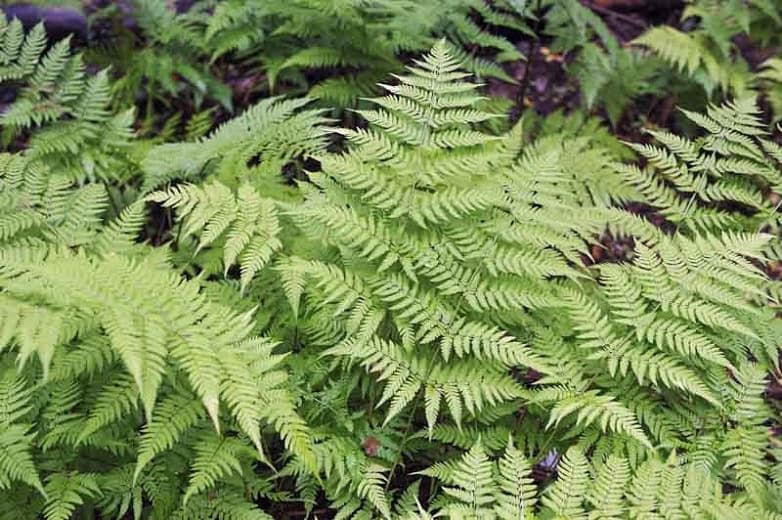

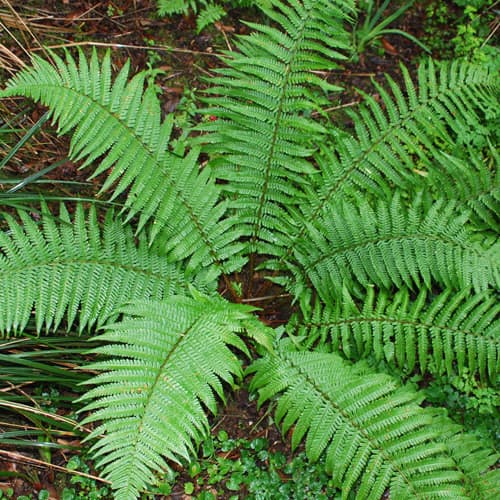
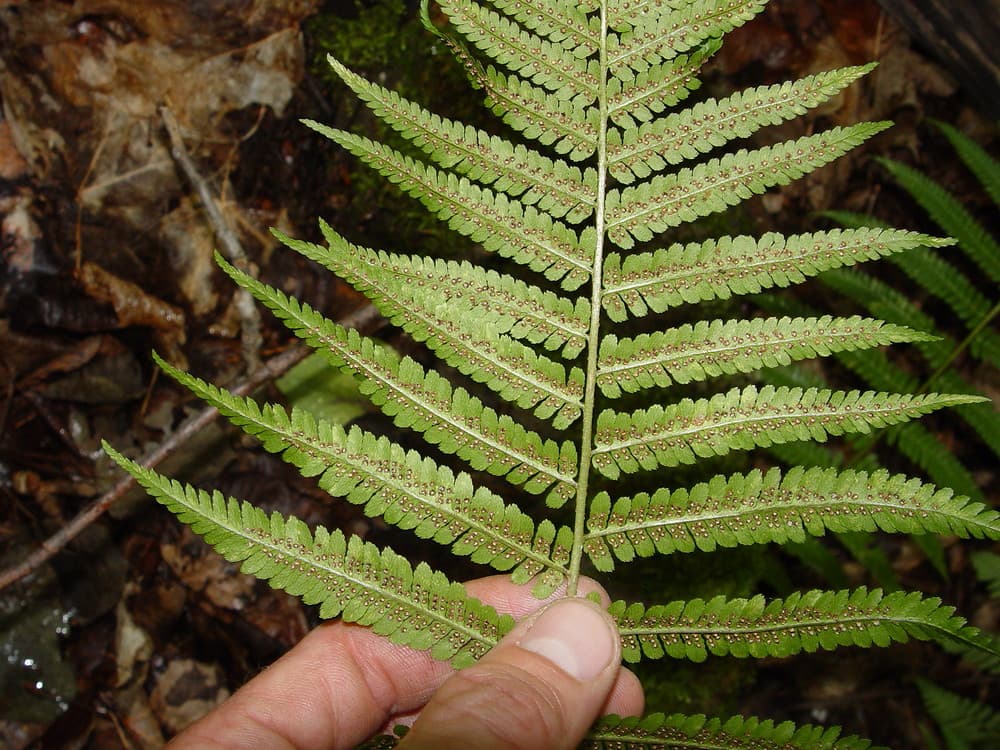
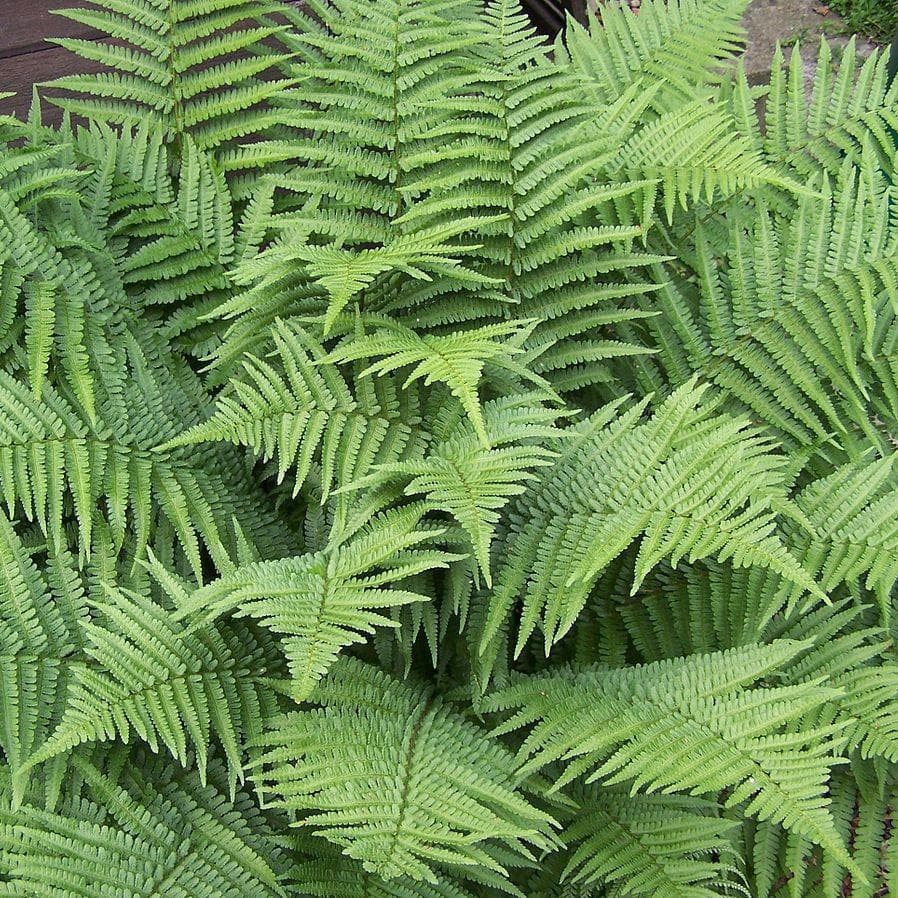
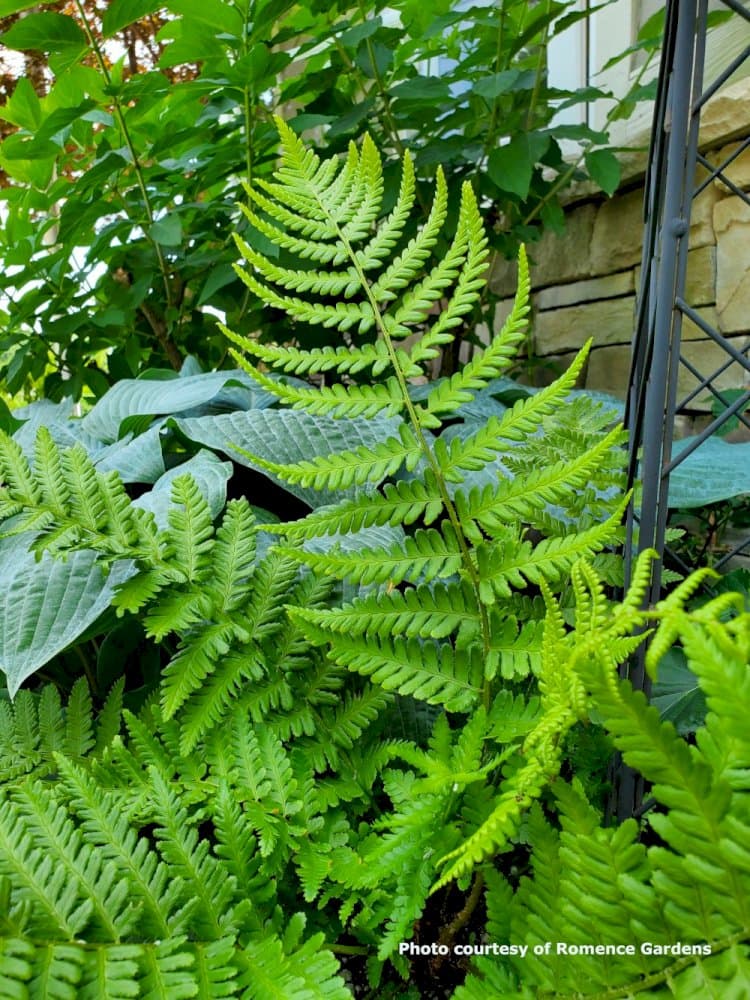
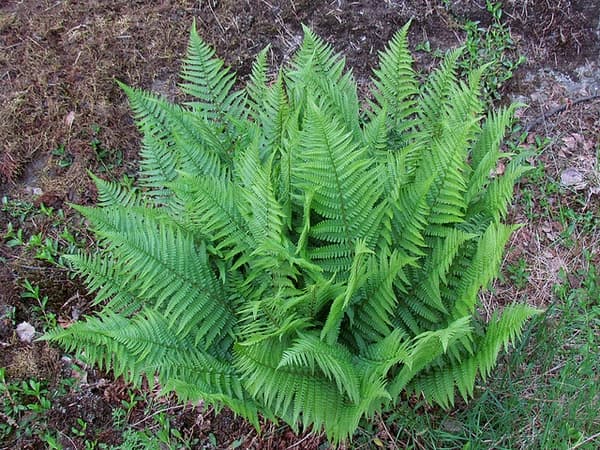

ABOUT
The plant known as Male Fern is characterized by its particularly elegant and intricate fronds, which bear a resemblance to a feather. Its leaves are distinctively narrow and elongated, and they tend to split at the ends, creating a multitude of thin, thread-like segments that give the fronds a delicate, lacey appearance. This unique splitting at the tips of the leaves is what gives the 'Linearis Polydactyla' its distinctive look, hence the polysyllabic component of its name which suggests many fingers, alluding to the multiple points at the frond tips. The foliage is a rich shade of green, creating a lush and verdant display. The fronds emanate in a graceful, arching form from a central clump, giving the plant an elegant silhouette that adds texture and depth to the garden. The plant's leaves are arranged in a way that makes them look somewhat erect and symmetrical, showing a well-organized structure that stands out in shaded garden spaces or woodland settings. Despite the lack of specific size mentions, it's important to acknowledge that Male Fern is a robust plant with a commanding presence due to its structural foliage. Its overall appearance is one of natural elegance and tranquility, often found adding a touch of forest beauty to gardens or functioning as a filler in mixed borders or shaded areas. Its deeply dissected leaves ensure it remains an eye-catching choice for gardeners looking for something that provides aesthetic interest without the need for bright flowers or bold color, making it a mainstay in shaded or woodland gardens.
About this plant
 Names
NamesFamily
Dryopteridaceae
Synonyms
Male Fern, Linearis Polydactyla Fern, Narrow Crested Male Fern
Common names
Dryopteris filix-mas var. linearis polydactyla.
 Toxicity
ToxicityTo humans
The common name of Dryopteris filix-mas 'Linearis Polydactyla' is Male Fern. Male Fern is not typically considered highly toxic to humans; however, like many ferns, it contains substances that may be irritating to the skin or digestive system if handled or ingested. If any part of the plant is ingested in large quantities, it could potentially cause digestive upset, such as diarrhea or stomach cramps. Historically, extracts of Male Fern have been used medicinally to treat parasitic worms, but such use is not without risk and should only be done under medical supervision due to potential toxicity.
To pets
The Male Fern is known to have low toxicity to pets. However, as with many non-toxic plants, if pets consume large amounts of the fern, they might experience mild gastrointestinal discomfort, which could include symptoms like vomiting or diarrhea. In general, the Male Fern is not a common cause of serious poisoning in pets, but it is always best to prevent pets from eating ornamental plants as a precautionary measure.
 Characteristics
CharacteristicsLife cycle
Perennials
Foliage type
Evergreen
Color of leaves
Green
Height
3-4 feet (0.9-1.2 meters)
Spread
2-3 feet (0.6-0.9 meters)
Plant type
Fern
Hardiness zones
5
Native area
Europe
Benefits
 General Benefits
General Benefits- Ecosystem support: Provides habitat and food for various insects and small wildlife.
- Aesthetic appeal: Adds visual interest to gardens with its unique feathery and dissected fronds.
- Shade tolerance: Grows well in shaded areas where other plants might struggle.
- Soil stabilization: Helps to prevent soil erosion in shaded and woodland areas.
- Low maintenance: Requires little care once established, making it a convenient choice for gardeners.
- Seasonal interest: Offers vibrant greenery throughout the growing season and can be evergreen in milder climates.
 Medical Properties
Medical PropertiesThis plant is not used for medical purposes.
 Air-purifying Qualities
Air-purifying QualitiesThis plant is not specifically known for air purifying qualities.
 Other Uses
Other Uses- The male fern can be used as natural dye; the plant provides a range of colors from yellow to green when used in fabric dyeing processes.
- In traditional craft, the fronds of the male fern can be pressed into paper or mixed into handmade paper pulp to add texture and visual interest.
- In some cultures, the fronds of this fern are used to create patterns in pottery by pressing them into wet clay before firing.
- Male fern can be used in floral arrangements, particularly in woodland-themed or rustic designs, where its fronds offer a delicate and feathery contrast.
- Gardeners sometimes use dried fronds of the male fern as a natural mulch to suppress weeds and retain soil moisture.
- The male fern's dense foliage can serve as a natural privacy screen for gardens or backyards, growing tall enough to provide a living wall.
- This plant can be used in terrariums or vivariums to create a naturalistic environment for small reptiles and amphibians.
- The fronds of the male fern, due to their intricate patterns, can be used as inspiration or direct subjects in botanical illustration and photography.
- In outdoor education, the male fern can be used to teach identification and appreciation of native plant species, as well as biodiversity in woodland ecosystems.
- For natural play areas, the non-toxic nature of the male fern allows it to be planted where children can touch and explore plants safely.
Interesting Facts
 Feng Shui
Feng ShuiThe Male Fern is not used in Feng Shui practice.
 Zodiac Sign Compitability
Zodiac Sign CompitabilityThe Male Fern is not used in astrology practice.
 Plant Symbolism
Plant Symbolism- Protection: The common name of Dryopteris filix-mas 'Linearis Polydactyla' is Male Fern. Male Fern is traditionally associated with protection due to its hardy nature and its historical use in warding off evil spirits.
- Health: Male Ferns have been used in herbal medicine, symbolizing health and well-being. Their use in traditional remedies lends them an association with healing.
- Secretiveness: In the language of plants, ferns often symbolize secrecy and discretion because of their quiet, unobtrusive presence in the forest understory.
- Eternal Youth: Ferns, with their lush, green fronds that unfurl from tight spirals known as fiddleheads, oftentimes symbolize new life, renewal, and the quest for eternal youth.
- Solitude: The Male Fern, like many ferns, thrives in damp, shaded forests and quiet places, leading to its symbolic association with solitude and a preference for peaceful, contemplative environments.
- Shelter: Given the fern’s propensity for growing in dense clumps, ferns like the Male Fern are also emblematic of shelter, offering a safe haven for small forest creatures.
 Water
WaterThe Male Fern should be watered deeply when the soil surface feels dry to the touch. Generally, watering once a week is sufficient, but during hot or dry spells, more frequent watering may be required, such as twice a week. Provide enough water to moisten the soil to a depth of about 6 inches – for a medium-sized pot, this typically means around 16-24 ounces of water. Always check the soil moisture before watering to avoid overwatering, as Male Fern prefers a consistently moist, but not waterlogged, soil environment.
 Light
LightMale Fern thrives best in partial to full shade conditions, so it's ideal to place the plant in a location where it can receive filtered or indirect light. Avoid direct sunlight, especially during the hottest parts of the day, as it can scorch the delicate fronds of the fern. A north-facing window or a spot under a tree that provides dappled sunlight would be an ideal setting for this fern.
 Temperature
TemperatureMale Fern prefers a temperate climate with temperatures ranging between 60 to 72 degrees Fahrenheit for optimal growth. The plant can tolerate a minimum temperature down to about 50 degrees Fahrenheit, while maximum temperatures should not exceed 75 degrees Fahrenheit. These temperature ranges help to replicate the Male Fern's natural habitat and encourage healthy growth.
 Pruning
PruningPruning the Male Fern is generally conducted to remove any dead or damaged fronds, which maintains the plant's appearance and health. This should be done in early spring before new growth begins. Pruning can be done as needed throughout the year, but sparingly, as ferns do not require significant pruning. The best time for a more thorough pruning is late winter or early spring before new fronds uncurl.
 Cleaning
CleaningAs needed
 Soil
SoilMale Fern prefers a soil mix rich in organic matter with good drainage; a blend of loamy soil, peat, and sand maintains moisture while avoiding waterlogging. The ideal soil pH for Male Fern is slightly acidic to neutral, ranging from 5.5 to 7.0.
 Repotting
RepottingMale Fern should be repotted every two to three years to refresh the soil and provide room for growth. It is best to repot in the spring before the new growth starts.
 Humidity & Misting
Humidity & MistingMale Fern thrives best in moderate to high humidity levels, ideally between 50-70%. A humid environment simulates its natural habitat and supports lush frond development.
 Suitable locations
Suitable locationsIndoor
Keep Male Fern in indirect light with high humidity indoors.
Outdoor
Plant Male Fern in shade to part-shade, moist soil outdoors.
Hardiness zone
Male Fern is suitable for 3-11 USDA hardiness zones.
 Life cycle
Life cycleThe plant known as Dryopteris filix-mas 'Linearis Polydactyla', also referred to as the Male Fern, begins its life cycle as a spore, which germinates to produce a small, heart-shaped gametophyte. The gametophyte, or prothallus, grows and develops reproductive organs which then produce sperm and eggs. Fertilization occurs when water allows sperm to swim to an egg, leading to the formation of a zygote. The zygote develops into a new sporophytic plant, recognizable by its classic fern frond structure. As the Male Fern matures, it produces sori on the underside of its fronds, where spores are formed and released to start a new generation. The cycle continues with the dispersal of spores and the potential for them to germinate in suitable conditions, perpetuating the species' existence.
 Propogation
PropogationPropogation time
Spring-Early Summer
The Male Fern, scientifically known as Dryopteris filix-mas 'Linearis Polydactyla', is typically propagated through spores, which can be collected and sown when they are ripe, usually in late summer. The most popular method is spore propagation, which involves collecting spores from the undersides of mature fronds as they turn brown. Once harvested, the spores are sown on the surface of a sterilized, finely milled peat and sand mix, or peat and perlite mix, kept in a warm place with high humidity, and out of direct sunlight. A plastic cover or glass can be used to maintain the necessary humidity. Germination occurs anywhere between a few weeks to several months, with the resulting gametophyte (prothallus) eventually producing new fern plants. It is a delicate process that requires patience and careful attention to environmental conditions to ensure successful growth.
